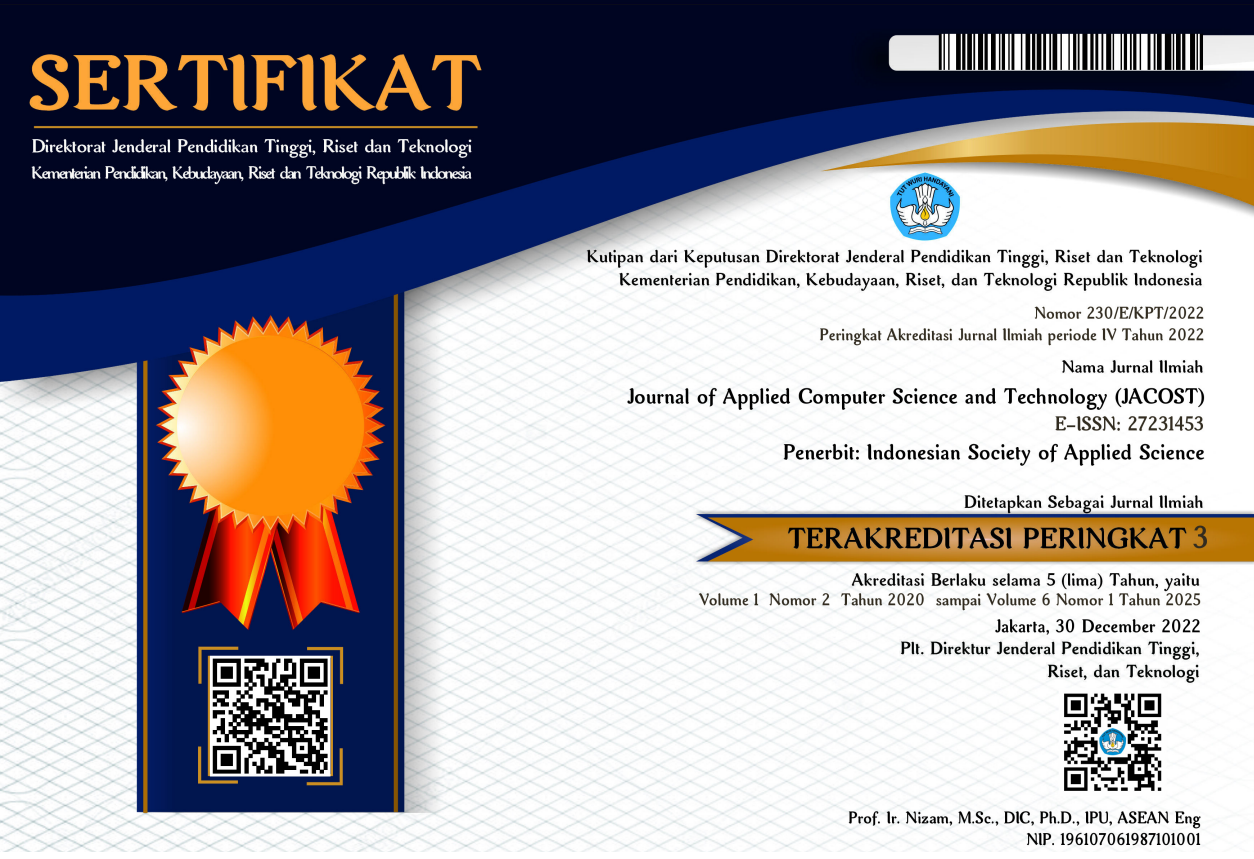Dataset Gambar Wajah untuk Analisis Personal Identification
DOI:
https://doi.org/10.52158/jacost.v3i2.427Keywords:
dataset, image pre-processing, personal identificationAbstract
In today's era, which is supported by technological advances, personal assistance through the face can be carried out by sophisticated machines and robots. One of its applications is personal identification using data mining. But before conducting data training and data classification, it is necessary to carry out the process of data collection and data cleaning or data pre-processing. Currently the face dataset for personal identification at the Caltex Riau Polytechnic in particular is still in the form of raw data, namely in the form of a collection of images that have not been pre-processed. Therefore, this research will perform image preprocessing to clean up the image data that has been collected so that the data can become a cleaner source of information and can be used at a later stage. The data used in this study are image data or photos of Caltex Riau Polytechnic students. At the facial image pre-processing stage using the OpenCV library using the Python programming language. Images collected by 500 students for 5 students. The results of this study are the personal identification dataset of Caltex Riau Polytechnic students consisting of 280 images that have successfully passed the stages of grayscaling, cropping, resizing and Normalization. This dataset is stored in the file data_norm.npz. White box testing is carried out to determine the accuracy of the application of the image pre-processing stage with the test results stating that all functional basis paths applied are in accordance with the cyclometic complexity and its independent path.
Downloads
References
S. Matsuda and H. Yoshimura, “Personal identification with artificial intelligence under COVID-19 crisis: a scoping review,” Syst. Rev., vol. 11, no. 1, p. 7, Dec. 2022, doi: 10.1186/s13643-021-01879-z.
J.-A. Lee and K.-C. Kwak, “Personal Identification Using an Ensemble Approach of 1D-LSTM and 2D-CNN with Electrocardiogram Signals,” Appl. Sci., vol. 12, no. 5, p. 2692, Mar. 2022, doi: 10.3390/app12052692.
S. N. Tkachenko, A. V Pichugina, A. A. Shpilevoy, and A. I. Zakharov, “Development of a Face Identification System’s Prototype,” J. Phys. Conf. Ser., vol. 2224, no. 1, p. 012003, Apr. 2022, doi: 10.1088/1742-6596/2224/1/012003.
Y. Kim, T. Soyata, and R. F. Behnagh, “Towards Emotionally Aware AI Smart Classroom: Current Issues and Directions for Engineering and Education,” IEEE Access, vol. 6, pp. 5308–5331, 2018, doi: 10.1109/ACCESS.2018.2791861.
M. Oravec, “Feature extraction and classification by machine learning methods for biometric recognition of face and iris,” Proc. Elmar - Int. Symp. Electron. Mar., no. September, pp. 1–4, 2014, doi: 10.1109/ELMAR.2014.6923301.
K. Delgado et al., “Student Engagement Dataset,” in 2021 IEEE/CVF International Conference on Computer Vision Workshops (ICCVW), Oct. 2021, pp. 3621–3629, doi: 10.1109/ICCVW54120.2021.00405.
B. K. Durga and D. V Rajesh, “Review Of Facial Emotion Recognition System,” Int. J. Pharm. Res., vol. 10, no. 03, Jul. 2018, doi: 10.31838/ijpr/2018.10.03.056.
F. Fadlisyah, Computer Vision dan Pengolahan Citra. ANDI Yogjakarta, 2007.
S. Puspitodjati and T. A. Wirana, “Sistem Pengenalan Ekspresi Wajah Berdasarkan Citra Wajah Menggunakan Metode Eigenface dan Nearest Feature Line,” Komput. Dan Sist. Intelijen, vol. 7, no. 2302–3740, pp. 311–316, 2012, [Online]. Available: http://penelitian.gunadarma.ac.id/kommit.
A. Riadi and R. Sulaehani, “Analisis Implementasi Preprocessing Dengan Otsu-Gaussian Pada Pengenalan Wajah,” Ilk. J. Ilm., vol. 11, no. 3, pp. 200–205, Dec. 2019, doi: 10.33096/ilkom.v11i3.457.200-205.
G. N. Girish, C. L. Shrinivasa Naika, and P. K. Das, “Face recognition using MB-LBP and PCA: A comparative study,” 2014 Int. Conf. Comput. Commun. Informatics Ushering Technol. Tomorrow, Today, ICCCI 2014, pp. 1–6, 2014, doi: 10.1109/ICCCI.2014.6921773.
M. Agarwal, H. Agrawal, N. Jain, and M. Kumar, “Face recognition using principle component analysis, eigenface and neural network,” 2010 Int. Conf. Signal Acquis. Process. ICSAP 2010, pp. 310–314, 2010, doi: 10.1109/ICSAP.2010.51.
T. Mulyono, K. Adi, and R. Gernowo, “Sistem Pengenalan Wajah Dengan Metode Eigenface Dan Jaringan Syaraf Tiruan (Jst),” Berk. Fis., vol. 15, no. 1, pp. 15–20, 2012.
Downloads
Published
Issue
Section
License
Pernyataan Hak Cipta dan Lisensi
Dengan mengirimkan manuskrip ke Journal of Applied Computer Science and Technology (JACOST), penulis setuju dengan kebijakan ini. Tidak diperlukan persetujuan dokumen khusus.
- Hak cipta pada setiap artikel adalah milik penulis.
- Penulis mempertahankan semua hak mereka atas karya yang diterbitkan, tak terbatas pada hak-hak yang diatur dalam laman ini.
- Penulis mengakui bahwa Journal of Applied Computer Science and Technology (JACOST) sebagai yang pertama kali mempublikasikan dengan lisensi Creative Commons Atribusi 4.0 Internasional (CC BY-SA).
- Penulis dapat memasukan tulisan secara terpisah, mengatur distribusi non-ekskulif dari naskah yang telah terbit di jurnal ini kedalam versi yang lain (misal: dikirim ke respository institusi penulis, publikasi kedalam buku, dll), dengan mengakui bahwa naskah telah terbit pertama kali pada Journal of Applied Computer Science and Technology (JACOST);
- Penulis menjamin bahwa artikel asli, ditulis oleh penulis yang disebutkan, belum pernah dipublikasikan sebelumnya, tidak mengandung pernyataan yang melanggar hukum, tidak melanggar hak orang lain, tunduk pada hak cipta yang secara eksklusif dipegang oleh penulis.
- Jika artikel dipersiapkan bersama oleh lebih dari satu penulis, setiap penulis yang mengirimkan naskah menjamin bahwa dia telah diberi wewenang oleh semua penulis bersama untuk menyetujui hak cipta dan pemberitahuan lisensi (perjanjian) atas nama mereka, dan setuju untuk memberi tahu rekan penulis persyaratan kebijakan ini. Journal of Applied Computer Science and Technology (JACOST) tidak akan dimintai pertanggungjawaban atas apa pun yang mungkin timbul karena perselisihan internal penulis.
Lisensi :
Journal of Applied Computer Science and Technology (JACOST) diterbitkan berdasarkan ketentuan Lisensi Creative Commons Atribusi 4.0 Internasional (CC BY-SA). Lisensi ini mengizinkan setiap orang untuk :.
- Berbagi — menyalin dan menyebarluaskan kembali materi ini dalam bentuk atau format apapun;
- Adaptasi — menggubah, mengubah, dan membuat turunan dari materi ini untuk kepentingan apapun.
Lisensi :
-
Atribusi — Anda harus mencantumkan nama yang sesuai, mencantumkan tautan terhadap lisensi, dan menyatakan bahwa telah ada perubahan yang dilakukan. Anda dapat melakukan hal ini dengan cara yang sesuai, namun tidak mengisyaratkan bahwa pemberi lisensi mendukung Anda atau penggunaan Anda.
-
BerbagiSerupa — Apabila Anda menggubah, mengubah, atau membuat turunan dari materi ini, Anda harus menyebarluaskan kontribusi Anda di bawah lisensi yang sama dengan materi asli.

















